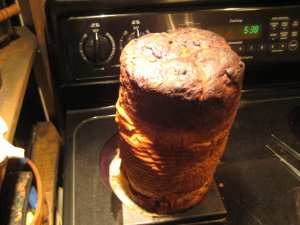
Before my lethal injection, I want pasta. Lots of pasta with as much bolognese I can stuff down. (I also want pizza and ice cream, but that's another story).




Ingredients:
1 cup raisins
2 Tbs light rum
2/3 cup tepid water plus 2 Tbs hot water, divided
3 ¾ cups all purpose flour
2/3 cup sugar
½ tsp salt
½ tsp instant dry yeast
¼ tsp grated lemon zest
½ vanilla bean, split lengthwise (I used 1 tsp vanilla extract)
3 large eggs, at room temperature
1 Tbs honey
12 ½ Tbs unsalted butter (10 ½ Tbs cut into Tbs size pieces and well softened; 1 Tbs melted; and 1 Tbs chilled)
2/3 cup candied fruits, chopped into small pieces if large.
Procedure:
Soak raisins in rum and 2 Tbs hot water (8 hours or overnight)
Mix flour, sugar, salt, yeast, lemon zest, and vanilla bean in stand mixer bowl with paddle until well mixed. In another bowl, whisk together the eggs, the honey, and the 2/3 cup of tepid water. With mixer at low speed, slowly pour the egg mixture into the flour mixture – up speed to medium low, and continue mixing until well combined. Add 10 ½ Tbs softened butter, 1 Tbs at a time, mixing until well incorporated between additions (Frozen/cold butter softens nicely in the microwave, but since each is sooo different, you’ll have to experiment to find the perfect time for yours – mine would be soft in about 15-25 seconds for this chunk.). Increase mixer speed to med high and mix until dough is smooth and elastic – about 8 minutes.
Drain raisins and mix with chopped fruit and 1 Tbs melted butter – stir into the dough mixture with a wooden spoon.
Put mixture into a large bowl, cover with plastic wrap, and put into a cold oven for 12-15 hours.
Lightly flour a board, and put the dough on the board – remove the vanilla bean, and sprinkle a light dusting of flour over the dough – pull the edges of the dough up onto itself, and turn it over into a ball.
Prepare your Panettone mold with either a paper liner or a piece of baker’s parchment held with a paper clip – move the dough into the mold, cover with a damp kitchen towel (not terry), and put in a warm spot where it can rise for 3-5 hours.
With an hour left in the dough rising time, turn your oven on to 370 degrees, and heat.
Cut an X in the top of the risen Panettone, and place the remaining Tbs of cold butter in the middle of the X – Put the Panettone mold/can on a baking sheet/pan and bake for an hour to an hour and a quarter – I needed 1 and ½ hours – test doneness with a skewer; it should be moist but clean – if you see dough, give it another 5-10 minutes.
When done, remove from oven, and remove from mold/can – measure 1 inch from the bottom of the Panettone and slide 4 skewers through the bottom from one side to the other – now suspend the Panettone upside down into a large stock pot (or two chairs), and let it cool completely, about 1 hour.

Panettone – a worthy addition to the special treats of Butter Season – and a holiday tradition that deserves, at least, to be on every baker’s resume. Try it – it may become your tradition too.



 Each day I walked quickly through Piazza Navona on my way to Cantina del Vecchio. From my building, I turned left from the door. Walked about 30 yards to the corner. Turned left. Crossed Corso dei Rinascimento and diagonally crossed Piazza Navona (from south to north) and turned left at the corner of the restuaruant Tre Scalini.
Each day I walked quickly through Piazza Navona on my way to Cantina del Vecchio. From my building, I turned left from the door. Walked about 30 yards to the corner. Turned left. Crossed Corso dei Rinascimento and diagonally crossed Piazza Navona (from south to north) and turned left at the corner of the restuaruant Tre Scalini. 





McDonalds have about twenty joints all around town now. They first opened here about fifteen years ago with a place in Piazza Di Spagna. At that time Rome city council was very suspicious of the whole idea, so they specified to MacDonalds that they had to build a restaurant which was in character with the historical architecture and culture of the area, both inside and out.
McDonalds responded by building the most bizarre McD's restaurant you'll ever see - The facade is very low key, not the familiar red and yellow corporate colors, but gold lettering on dark grey marble, so it's difficult to spot at first. Inside, you'll find mock-marble replica fountains, real terra-cotta brickwork, fresco murals, salad bars and displays of fresh fruit in wooden barrows similar to those in Campo dei Fiori.
Other branches added later around other districts of Rome are more conventional in appearance. Although there's now a McDonalds in every far-flung suburb of Rome, the main locations you'll need as a tourist in the central Rome area are at:
Piazza Di Spagna
Via del Corso
Piazza Barberini
Via Nazionale
Piazza della Repubblica
Piazza della Rotonda (opposite the Pantheon)
Piazza Sidney Sonnino (in Trastevere)


 Cantina del Vecchio has two main partners -- Allan and Vittorio -- and one of them is in the "front of the house," in the restaurant dining room, at all times. That's seven days a week, from early morning until late -- really late.
Cantina del Vecchio has two main partners -- Allan and Vittorio -- and one of them is in the "front of the house," in the restaurant dining room, at all times. That's seven days a week, from early morning until late -- really late.